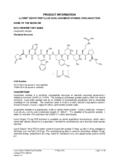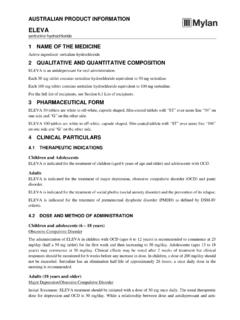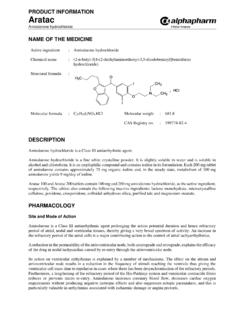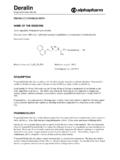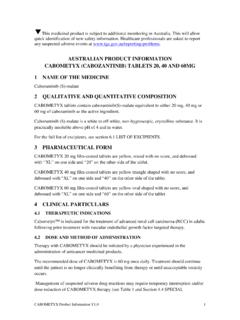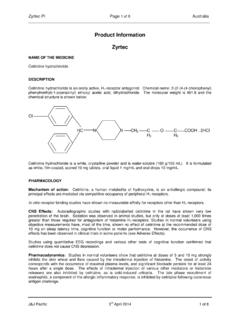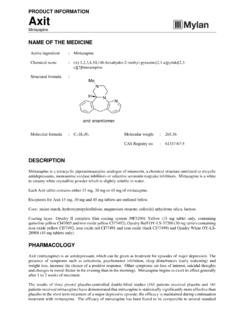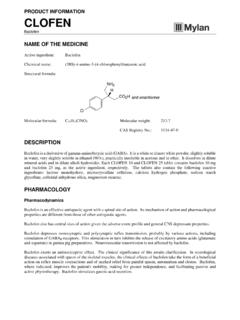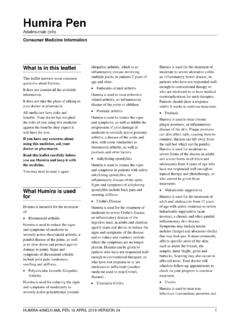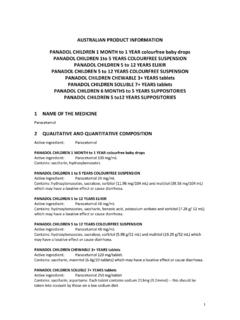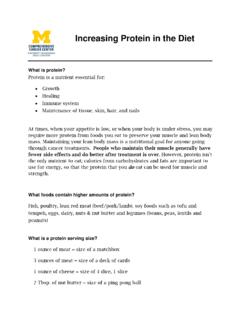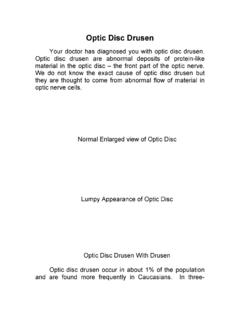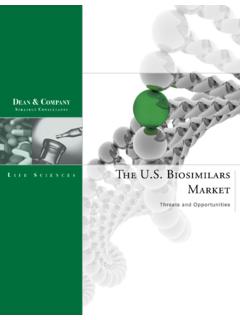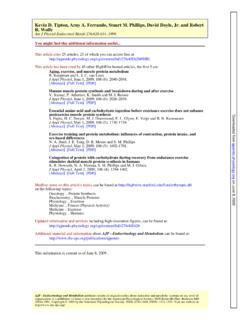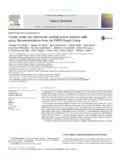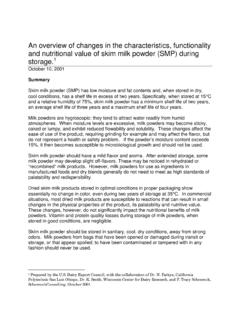Transcription of ALPRIM - Medicines
1 ALPRIM Trimethoprim PRODUCT INFORMATION NAME OF THE MEDICINE Active ingredient: Trimethoprim Chemical name: 5-(3,4,5-trimethoxybenzyl)-pyrimidine-2, 4-diamine Structural formula: Molecular formula: C14H18N4O3 Molecular weight: CAS Registry No.: 738-70-5 DESCRIPTION Synthetic antibacterial. It is a white, or yellowish-white powder, odourless or almost odourless. Melting point about 200 C. Solubility 1:2500 of water, 1:300 in ethanol (96%), 1:55 of chloroform and 1:80 of methyl alcohol. Practically insoluble in ether. Each ALPRIM tablet contains trimethoprim 300 mg as the active ingredient. ALPRIM tablets also contain the following inactive ingredients: lactose monohydrate, povidone, sodium starch glycollate, purified talc, magnesium stearate.
2 PHARMACOLOGY Trimethoprim is rapidly absorbed following oral administration. Time to peak concentration in the circulation occur about to 4 hours after an oral dose. Food decreases the area under the plasma concentration-time curve by approximately 20%. The half-life of trimethoprim ranges from 8 to 12 hours in the presence of normal renal function. Approximately 44% of the drug is protein bound in the blood. In subjects receiving a single dose of 100 mg trimethoprim the urinary concentration ranged from 30 to 160 mcg/mL zero to 4 hours after the dose, and from 18 to 90 mcg/mL 8 to 24 hours after the dose. Increasing the dose of trimethoprim to 200 mg will double the urinary concentration.
3 Elimination is delayed in patients with renal insufficiency. The use of trimethoprim in patients with a creatinine clearance of less than 15 mL/minute is not recommended. ALPRIM Product Information 2 Microbiology Trimethoprim blocks the formation of tetrahydrofolic acid from dihydrofolic acid by binding to and reversibly inhibiting the enzyme dihydrofolate reductase. Its affinity for the bacterial dihydrofolate reductase enzyme is much stronger than for the corresponding mammalian enzyme. Thus trimethoprim selectively interferes with bacterial biosynthesis of nucleic acids and proteins. Trimethoprim is active in vitro against the common urinary tract pathogens.
4 Representative minimum inhibitory concentrations (MIC) for trimethoprim susceptible organisms Bacteria Trimethoprim MIC mcg/mL (range) Escherichia coli Proteus mirabilis Proteus sp. (indole positive) Klebsiella pneumoniae - - - - It is not active against Pseudomonas spp. Normal vaginal and faecal flora are the source of most pathogens causing urinary tract infections. It is therefore relevant to consider the suppressive effect of trimethoprim at these sites. Concentrations of trimethoprim in vaginal secretions are consistently greater than those found simultaneously in the serum, being typically times the concentration of simultaneously obtained serum samples.
5 Sufficient trimethoprim is excreted in the faeces to markedly reduce or eliminate trimethoprim susceptible organisms from the faecal flora. In vitro resistance develops rapidly when susceptible bacteria are passed through increasing concentrations of the drug. However, following clinical use there have been conflicting reports on the development of resistance to trimethoprim when used alone. The possibility of increasing resistance to trimethoprim cannot at present be ruled out. Generally, resistance is more likely to occur in hospital than in domiciliary use. Plasmid mediated as well as chromosomal resistance to trimethoprim have been reported. Microbiology, Susceptibility Tests Dilution or Diffusion Techniques.
6 Either quantitative (MIC) or breakpoint should be used following a regularly updated, recognised and standardised method ( NCCLS). Standardised susceptibility test procedures require the use of laboratory control microorganisms to control the technical aspects of the laboratory procedures. A report of Susceptible indicates that the pathogen is likely to be inhibited if the antimicrobial compound in the blood reaches the concentrations usually achievable. A report of Immediate indicates that the result should be considered equivocal, and if the microorganism is not fully susceptible to alternative, clinically feasible drugs, the test should be repeated. This category implies possible clinical applications in body sites where the drug is physiologically concentrated or in situations where high dosage of the drug is used.
7 This category also provides a buffer zone, which prevents small-uncontrolled technical factors from causing major discrepancies in interpretation. A report of Resistant indicates that the pathogen is not likely to be inhibited if the antimicrobial compound in the blood reaches the concentration usually achievable; other therapy should be selected. Note: the prevalence of resistance may vary geographically for selected species and local information on resistance is desirable, particularly when treating severe infections. ALPRIM Product Information 3 INDICATIONS Treatment of acute urinary tract infections caused by sensitive organisms. CONTRAINDICATIONS ALPRIM should not be given to patients with a history of trimethoprim hypersensitivity.
8 Patients with severely impaired renal function (creatinine clearance less than 10 mL/min) should not be prescribed ALPRIM unless the plasma concentration of trimethoprim is monitored repeatedly during treatment. ALPRIM should not be given to patients with severe haematological disorders or documented megaloblastic anaemia due to folate deficiency. PRECAUTIONS Electrolyte Abnormalities Close monitoring of serum electrolytes is advised in patients at risk of hyperkalaemia. These include older patients, those with renal impairment and those taking other Medicines that are known to increase serum potassium (see INTERACTIONS WITH OTHER Medicines and ADVERSE EFFECTS).
9 Use with caution in the following circumstances: Possible Folate Deficiency. Administration of folate supplementation should be considered. Impaired Renal Function. Trimethoprim may cause a significant, reversible increase in serum creatinine. Tubular secretion of creatinine is inhibited by trimethoprim. It should not be given in severe impairment unless blood concentrations can be monitored. Impaired Hepatic Function. Elderly Patients. Skin Rash. It should be discontinued if a skin rash appears. Regular monthly blood counts are advisable when ALPRIM is given for long periods since there exists a possibility of symptomatic changes in haematological laboratory indices due to lack of available folate.
10 Porphyria. Trimethoprim has been associated with acute attacks of porphyria and is considered unsafe in porphyria patients. Use in Pregnancy (Category B3) Trimethoprim may interfere with folic acid metabolism and animal experiments have shown that administration of very high doses of trimethoprim during organ development may give rise to birth defects typical of folic acid antagonism. If trimethoprim is given during pregnancy, folic acid supplementation may be required. Australian categorisation definition of Category B3. Drugs which have been taken by only a limited number of pregnant women and women of childbearing age, without an increase in the frequency of malformation or other direct or indirect harmful effects on the human foetus having been observed.
